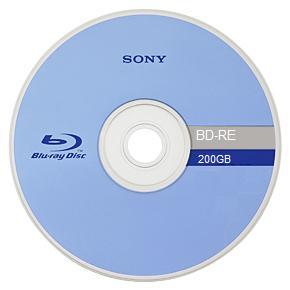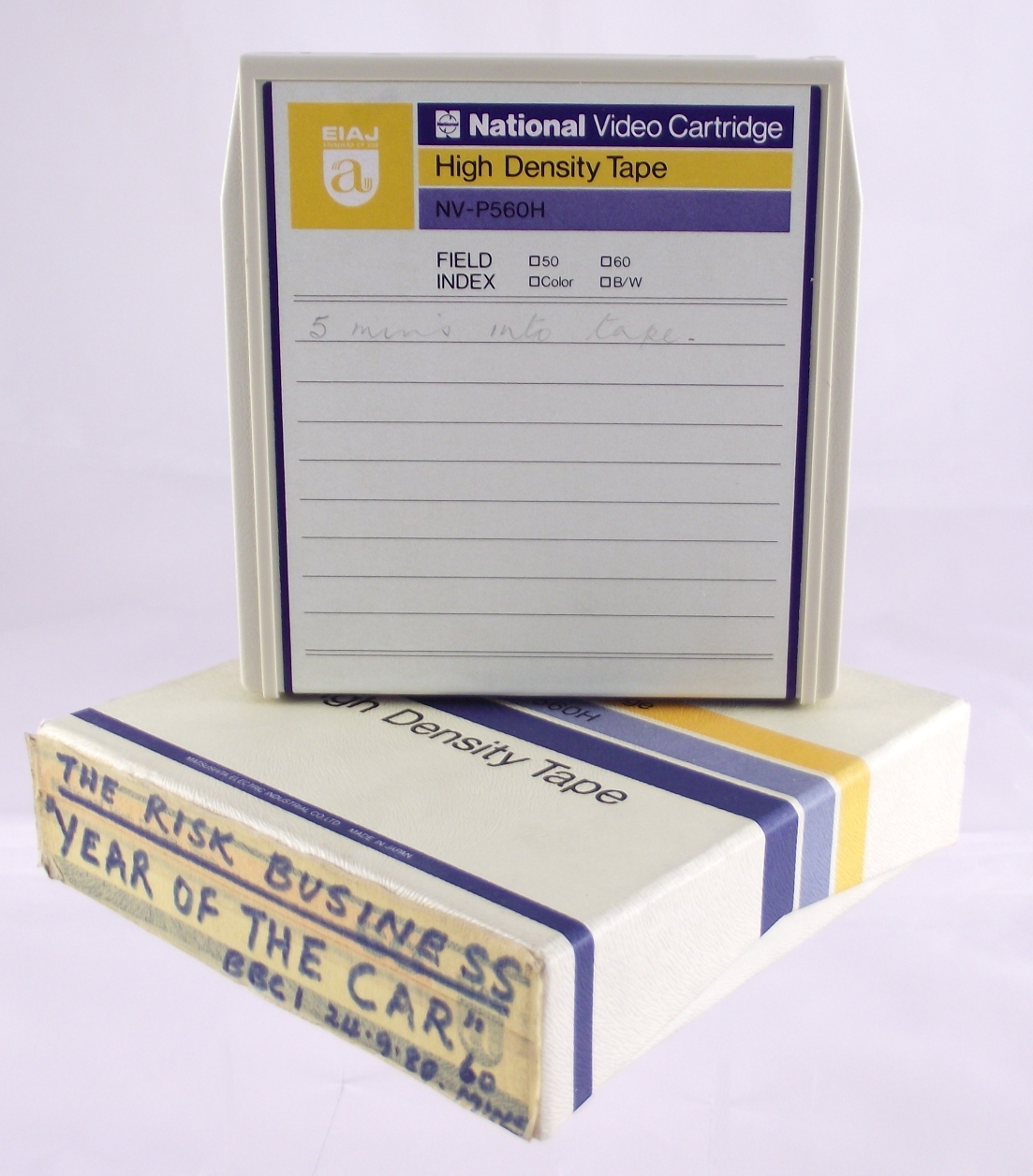|
CV-2000
CV-2000 was one of the world's first home video tape recorders (VTR), introduced by Sony in August 1965. The 'CV' in the model name stood for . This was Sony's domestic format throughout the 1960s. It was the first fully transistorized VCR. The CV-2000 was developed by Sony engineer Nobutoshi Kihara. On its release, the CV-2000D machine was listed for US$695——while a portable version in a more durable case, the CV-2000, was listed for $730—. It used video tape in a reel-to-reel format, meaning the tape had to be manually threaded around the helical scan video head drum. The CV-2000 was one-tenth the weight and price of other analog video recording products of its era. It recorded television programs in black and white using the skip field process, which produced a maximum 200-lines resolution. The tape moved at a speed of 7.5 inches per second. Two different reels were marketed: A reel of video tape listed for about US$22——had 30-minute playtime, and video-tape ... [...More Info...] [...Related Items...] OR: [Wikipedia] [Google] [Baidu] |
Video Tape Recorder
A video tape recorder (VTR) is a tape recorder designed to record and playback video and audio signal, audio material from magnetic tape. The early VTRs were open-reel devices that record on individual reels of 2-inch-wide (5.08 cm) tape. They were used in television studios, serving as a replacement for motion picture film stock and making recording for television applications cheaper and quicker. Beginning in 1963, videotape machines made instant replay during televised sporting events possible. Improved formats, in which the tape was contained inside a videocassette, were introduced around 1969; the machines which play them are called videocassette recorders. An agreement by Japanese manufacturers on a common standard recording format, which allowed cassettes recorded on one manufacturer's machine to play on another's, made a consumer market possible; and the first consumer videocassette recorder, which used the U-matic format, was introduced by Sony in 1971. History ... [...More Info...] [...Related Items...] OR: [Wikipedia] [Google] [Baidu] |
Sony
is a Japanese multinational conglomerate (company), conglomerate headquartered at Sony City in Minato, Tokyo, Japan. The Sony Group encompasses various businesses, including Sony Corporation (electronics), Sony Semiconductor Solutions (imaging and sensing), Sony Entertainment (including Sony Pictures and Sony Music Group), Sony Interactive Entertainment (video games), Sony Financial Group, and others. Sony was founded in 1946 as by Masaru Ibuka and Akio Morita. In 1958, the company adopted the name Initially an electronics firm, it gained early recognition for products such as the TR-55 transistor radio and the CV-2000 home video tape recorder, contributing significantly to Japan's Japanese economic miracle, post-war economic recovery. After Ibuka's retirement in the 1970s, Morita served as chairman until 1994, overseeing Sony's rise as a global brand recognized for innovation in consumer electronics. Landmark products included the Trinitron color television, the Walkma ... [...More Info...] [...Related Items...] OR: [Wikipedia] [Google] [Baidu] |
Sony Products
is a Japanese multinational conglomerate headquartered at Sony City in Minato, Tokyo, Japan. The Sony Group encompasses various businesses, including Sony Corporation (electronics), Sony Semiconductor Solutions (imaging and sensing), Sony Entertainment (including Sony Pictures and Sony Music Group), Sony Interactive Entertainment (video games), Sony Financial Group, and others. Sony was founded in 1946 as by Masaru Ibuka and Akio Morita. In 1958, the company adopted the name Initially an electronics firm, it gained early recognition for products such as the TR-55 transistor radio and the CV-2000 home video tape recorder, contributing significantly to Japan's post-war economic recovery. After Ibuka's retirement in the 1970s, Morita served as chairman until 1994, overseeing Sony's rise as a global brand recognized for innovation in consumer electronics. Landmark products included the Trinitron color television, the Walkman portable audio player, and the co-dev ... [...More Info...] [...Related Items...] OR: [Wikipedia] [Google] [Baidu] |
Nobutoshi Kihara
Nobutoshi Kihara (木原 信敏 ''Kihara Nobutoshi'', 14 October 1926 – 13 February 2011) was an engineer at Sony, best known for his work on the original Walkman cassette-tape player in the 1970s and was commonly called ''Mr. Walkman'' in the press. Born in Tokyo, Kihara attended Waseda University, then joined Sony's predecessor, Tokyo Telecommunications Engineering Corporation in 1947 as a new university graduate. He retired from Sony in 2006. While at Sony, he worked on Japan's first magnetic tape recorders, portable tape recorders, music stereo systems, Betamax video, digital cameras, a compact cassette magazine-type recorder and Japan's first transistor radio. In 1964, a team led by Kihara developed the CV-2000, the world's first VTR intended for home usage. He also was instrumental in creating cassette versions of the VTR (Video Tape Recorder),established the basis for the U-matic system. In 1981, was involved in the development of the Mavica digital still camera, wh ... [...More Info...] [...Related Items...] OR: [Wikipedia] [Google] [Baidu] |
EIAJ-1
EIAJ-1 was a standard for video tape recorders (VTRs) developed by the Electronic Industries Association of Japan with the cooperation and assistance of several Japanese electronics manufacturers in 1969. It was the first standardized format for industrial/non-broadcast VTRs using a helical scan system employing open reel tape. Previously, each manufacturer of machines in this market used a different proprietary format, with differing tape speeds, scanner drum diameters, bias frequencies, tracking head placement, and so on, although most used 1/2" wide tape. As a result, video tapes recorded on one make and/or model of VTR could only be interchanged with other machines using that specific format, hampering compatibility. For example, a reel of tape recorded on a Panasonic machine would not play on a Sony machine, and vice versa. The EIAJ-1 standard ended this incompatibility, giving those manufacturers a standardized format, interchangeable with almost all VTRs subsequently ... [...More Info...] [...Related Items...] OR: [Wikipedia] [Google] [Baidu] |
Skip Field
In video, skip field recording is a process in which only one field (one half of a frame) of video is recorded in order to conserve recording media space. For some kinds of recording, the quality loss of not using both fields of video is fairly negligible, it results in the loss of half of possible vertical video resolution and temporal resolution. It was a common method used in early telerecording systems, as well as early and current non-professional/industrial videotape formats such as CV-2000, Cartrivision and V-Cord. See also * Low-definition television Low-definition television (LDTV) refers to TV systems that have a lower screen resolution than standard-definition television systems. The term is usually used in reference to digital television, in particular when broadcasting at the same (or s ... Film and video technology {{Filming-stub ... [...More Info...] [...Related Items...] OR: [Wikipedia] [Google] [Baidu] |
Magnetic Tape
Magnetic tape is a medium for magnetic storage made of a thin, magnetizable coating on a long, narrow strip of plastic film. It was developed in Germany in 1928, based on the earlier magnetic wire recording from Denmark. Devices that use magnetic tape can with relative ease record and play back audio, visual, and binary computer data. Magnetic tape revolutionized sound recording and reproduction and broadcasting. It allowed radio, which had always been broadcast live, to be recorded for later or repeated airing. Since the early 1950s, magnetic tape has been used with computers to store large quantities of data and is still used for backup purposes. Magnetic tape begins to degrade after 10–20 years and therefore is not an ideal medium for long-term archival storage. The exception is data tape formats like Linear Tape-Open, LTO which are specifically designed for long-term archiving. Information in magnetic tapes is often recorded in tracks which are narrow and long areas of in ... [...More Info...] [...Related Items...] OR: [Wikipedia] [Google] [Baidu] |
Black-and-white
Black-and-white (B&W or B/W) images combine black and white to produce a range of achromatic brightnesses of grey. It is also known as greyscale in technical settings. Media The history of various visual media began with black and white, and as technology improved, altered to color. However, there are exceptions to this rule, including black-and-white fine art photography, as well as many film motion pictures and art film(s). Early photographs in the late 19th and early to mid 20th centuries were often developed in black and white, as an alternative to sepia due to limitations in film available at the time. Black and white was also prevalent in early television broadcasts, which were displayed by changing the intensity of monochrome phosphurs on the inside of the screen, before the introduction of colour from the 1950s onwards. Black and white continues to be used in certain sections of the modern arts field, either stylistically or to invoke the perception of a hist ... [...More Info...] [...Related Items...] OR: [Wikipedia] [Google] [Baidu] |
Film And Video Technology
A film, also known as a movie or motion picture, is a work of visual art that simulates experiences and otherwise communicates ideas, stories, perceptions, emotions, or atmosphere through the use of moving images that are generally, since the 1930s, synchronized with sound and (less commonly) other sensory stimulations. Etymology and alternative terms The name "film" originally referred to the thin layer of photochemical emulsion on the celluloid strip that used to be the actual medium for recording and displaying motion pictures. Many other terms exist for an individual motion-picture, including "picture", "picture show", "moving picture", "photoplay", and "flick". The most common term in the United States is "movie", while in Europe, "film" is preferred. Archaic terms include "animated pictures" and "animated photography". "Flick" is, in general a slang term, first recorded in 1926. It originates in the verb flicker, owing to the flickering appearance of early films. ... [...More Info...] [...Related Items...] OR: [Wikipedia] [Google] [Baidu] |
Products Introduced In 1965
Product may refer to: Business * Product (business), an item that can be offered to a market to satisfy the desire or need of a customer. * Product (project management), a deliverable or set of deliverables that contribute to a business solution Mathematics * Product (mathematics) Algebra * Direct product Set theory * Cartesian product of sets Group theory * Direct product of groups * Semidirect product * Product of group subsets * Wreath product * Free product * Zappa–Szép product (or knit product), a generalization of the direct and semidirect products Ring theory * Product of rings * Ideal operations, for product of ideals Linear algebra * Scalar multiplication * Matrix multiplication * Inner product, on an inner product space * Exterior product or wedge product * Multiplication of vectors: ** Dot product ** Cross product ** Seven-dimensional cross product ** Triple product, in vector calculus * Tensor product Topology * Product topology Algebraic topology * Cap prod ... [...More Info...] [...Related Items...] OR: [Wikipedia] [Google] [Baidu] |
Audiovisual Introductions In 1965
Audiovisual (AV) is electronic media possessing both a sound and a visual component, such as slide-tape presentations, films, television programs, corporate conferencing, church services, and live theater productions. Audiovisual service providers frequently offer web streaming, video conferencing, and live broadcast services. The professional audio visual industry has companies that provide hardware, software and services. These organizations are commonly referred to as ''systems integrators'' and perform both the installation and integration of different types of AV equipment from multiple manufacturers into spaces to create the AV experience for the user or audience. Computer-based audiovisual equipment is often used in education, with many schools and universities installing projection equipment and using interactive whiteboard technology. Components Aside from equipment installation, two significant elements of audiovisual are wiring and system control. If either of the ... [...More Info...] [...Related Items...] OR: [Wikipedia] [Google] [Baidu] |







